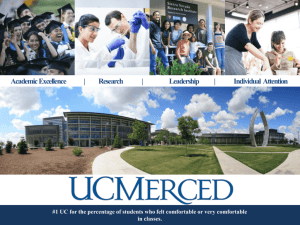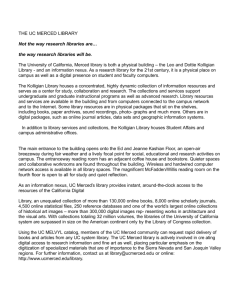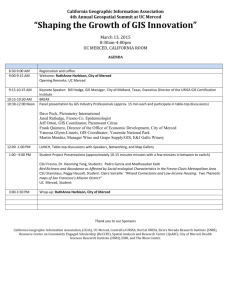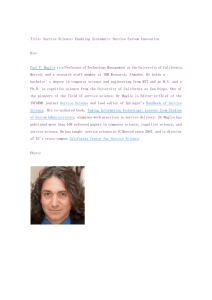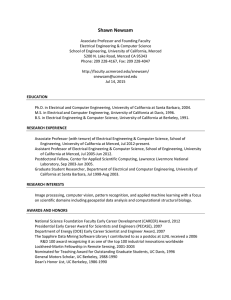Researchers meld robots, humans -- MercedSunStar.com :: Merced New...
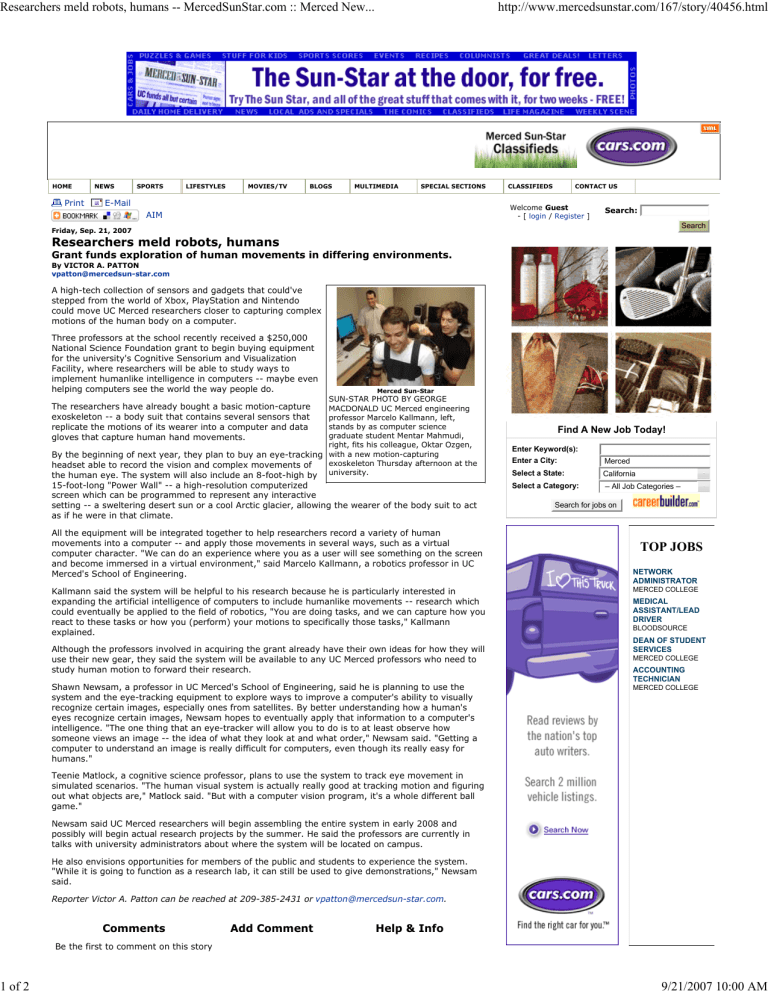
Researchers meld robots, humans -- MercedSunStar.com :: Merced New...
http://www.mercedsunstar.com/167/story/40456.html
1 of 2
HOME
NEWS
SPORTS
AIM
LIFESTYLES MOVIES/TV BLOGS MULTIMEDIA SPECIAL SECTIONS
Friday, Sep. 21, 2007
Researchers meld robots, humans
Grant funds exploration of human movements in differing environments.
By VICTOR A. PATTON vpatton@mercedsun-star.com
A high-tech collection of sensors and gadgets that could've stepped from the world of Xbox, PlayStation and Nintendo could move UC Merced researchers closer to capturing complex motions of the human body on a computer.
Three professors at the school recently received a $250,000
National Science Foundation grant to begin buying equipment for the university's Cognitive Sensorium and Visualization
Facility, where researchers will be able to study ways to implement humanlike intelligence in computers -- maybe even helping computers see the world the way people do.
The researchers have already bought a basic motion-capture exoskeleton -- a body suit that contains several sensors that replicate the motions of its wearer into a computer and data gloves that capture human hand movements.
By the beginning of next year, they plan to buy an eye-tracking headset able to record the vision and complex movements of
Merced Sun-Star
SUN-STAR PHOTO BY GEORGE
MACDONALD UC Merced engineering professor Marcelo Kallmann, left, stands by as computer science graduate student Mentar Mahmudi, right, fits his colleague, Oktar Ozgen, with a new motion-capturing exoskeleton Thursday afternoon at the university.
the human eye. The system will also include an 8-foot-high by
15-foot-long "Power Wall" -- a high-resolution computerized screen which can be programmed to represent any interactive setting -- a sweltering desert sun or a cool Arctic glacier, allowing the wearer of the body suit to act as if he were in that climate.
All the equipment will be integrated together to help researchers record a variety of human movements into a computer -- and apply those movements in several ways, such as a virtual computer character. "We can do an experience where you as a user will see something on the screen and become immersed in a virtual environment," said Marcelo Kallmann, a robotics professor in UC
Merced's School of Engineering.
Kallmann said the system will be helpful to his research because he is particularly interested in expanding the artificial intelligence of computers to include humanlike movements -- research which could eventually be applied to the field of robotics, "You are doing tasks, and we can capture how you react to these tasks or how you (perform) your motions to specifically those tasks," Kallmann explained.
Although the professors involved in acquiring the grant already have their own ideas for how they will use their new gear, they said the system will be available to any UC Merced professors who need to study human motion to forward their research.
Shawn Newsam, a professor in UC Merced's School of Engineering, said he is planning to use the system and the eye-tracking equipment to explore ways to improve a computer's ability to visually recognize certain images, especially ones from satellites. By better understanding how a human's eyes recognize certain images, Newsam hopes to eventually apply that information to a computer's intelligence. "The one thing that an eye-tracker will allow you to do is to at least observe how someone views an image -- the idea of what they look at and what order," Newsam said. "Getting a computer to understand an image is really difficult for computers, even though its really easy for humans."
Teenie Matlock, a cognitive science professor, plans to use the system to track eye movement in simulated scenarios. "The human visual system is actually really good at tracking motion and figuring out what objects are," Matlock said. "But with a computer vision program, it's a whole different ball game."
Newsam said UC Merced researchers will begin assembling the entire system in early 2008 and possibly will begin actual research projects by the summer. He said the professors are currently in talks with university administrators about where the system will be located on campus.
He also envisions opportunities for members of the public and students to experience the system.
"While it is going to function as a research lab, it can still be used to give demonstrations," Newsam said.
Reporter Victor A. Patton can be reached at 209-385-2431 or vpatton@mercedsun-star.com
.
Comments
Be the first to comment on this story
Add Comment Help & Info
CLASSIFIEDS CONTACT US
Welcome Guest
- [ login / Register ]
Search:
Find A New Job Today!
Enter Keyword(s):
Enter a City:
Select a State:
Select a Category:
Merced
Search for jobs on
Search
TOP JOBS
NETWORK
ADMINISTRATOR
MERCED COLLEGE
MEDICAL
ASSISTANT/LEAD
DRIVER
BLOODSOURCE
DEAN OF STUDENT
SERVICES
MERCED COLLEGE
ACCOUNTING
TECHNICIAN
MERCED COLLEGE
